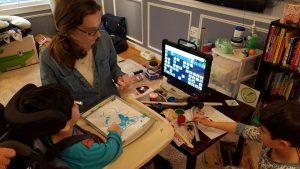 When I pulled out paint during my session with Joey a few weeks ago, a smile spread across his face. Joey knew immediately what I had planned. He went into his talky and said PAINT. Joey loves to paint, which is good because painting gives us so many good opportunities to incorporate language and fine motor goals, while tying these goals together with whatever theme or book we are focused on at the moment. In fact, when we read Seals on the Bus , Joey specifically used his eye gaze “talky” to ask me to paint. The next time I came back I brought yellow paint and a picture of a bus.
When I pulled out paint during my session with Joey a few weeks ago, a smile spread across his face. Joey knew immediately what I had planned. He went into his talky and said PAINT. Joey loves to paint, which is good because painting gives us so many good opportunities to incorporate language and fine motor goals, while tying these goals together with whatever theme or book we are focused on at the moment. In fact, when we read Seals on the Bus , Joey specifically used his eye gaze “talky” to ask me to paint. The next time I came back I brought yellow paint and a picture of a bus.
After reading two different versions of The Gingerbread Man, I decided we should paint our own gingerbread men. I brought four different colors of paint, an outline of a gingerbread man, and different types of brushes. Painting with Joey isn’t always the neatest activity, because his excitement can lead him to lose control of his muscles, causing him to sweep the brush into the air with wide sweeping motions, painting anything that happens to be in the vicinity. He can also become so overly excited that he grabs the paper and balls it up by accident. So far we’ve kept the paint away from his talky, but I’m sure one day the screen will also end up splattered with paint.
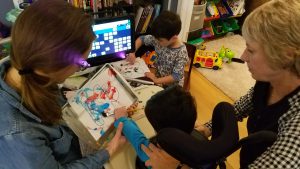 To help Joey, we tape the paper onto a cookie tray. The tray provides a slight lip so that Joey knows where the paper ends, but also allows us to pick the paper up and hold it closer or further away from Joey, while still having it on a hard surface. We can hold the tray, and move it so that he is painting the Gingerbread man’s arm, or leg, or head. Or, we can slightly tilt the tray up so that he has a slanted surface. The tray even has Velcro on the bottom so that we can leave it Velcro’ed to the tray of his wheelchair.
To help Joey, we tape the paper onto a cookie tray. The tray provides a slight lip so that Joey knows where the paper ends, but also allows us to pick the paper up and hold it closer or further away from Joey, while still having it on a hard surface. We can hold the tray, and move it so that he is painting the Gingerbread man’s arm, or leg, or head. Or, we can slightly tilt the tray up so that he has a slanted surface. The tray even has Velcro on the bottom so that we can leave it Velcro’ed to the tray of his wheelchair.
Painting not only gives Joey the chance to create something, but it gives him the power of choices. We work on his language by asking him what color paint he wants (and expect an answer from the talky). We can ask him what part of the gingerbread he wants to paint next, and he can use his body part words to tell us what part to do next. I want him to have the opportunity to make deliberate decisions about art, and then to be able to follow through and see how his individual decisions come together into a whole project. This, after all, is what we all do when we complete a project. At three, children are beginning to move from just marking a paper with random colors and lines on paper, to making purposeful marks and lines that represent something real. I want Joey to experience creating meaningful lines as well.
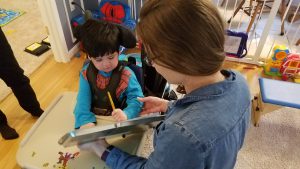 For this particular session, Joey’s older brother happened to be home from school, so he joined us in our painting project. Both boys seemed to enjoy being together, but what made it even better that his brother was there was that his brother’s presence provided him with motivation. Anyone who has been a teacher knows that once one child in a class gets a unique idea, others follow. So once Joey’s brother painted a mouth on his gingerbread man, what did Joey do? He studied the words in his talky for a bit before selecting ‘mouth’. Of course. If his brother’s gingerbread man had a mouth, then his gingerbread man needed a mouth too. But there is no way he would have painted a mouth if I suggested it. There is nothing quite like the love for an older sibling.
For this particular session, Joey’s older brother happened to be home from school, so he joined us in our painting project. Both boys seemed to enjoy being together, but what made it even better that his brother was there was that his brother’s presence provided him with motivation. Anyone who has been a teacher knows that once one child in a class gets a unique idea, others follow. So once Joey’s brother painted a mouth on his gingerbread man, what did Joey do? He studied the words in his talky for a bit before selecting ‘mouth’. Of course. If his brother’s gingerbread man had a mouth, then his gingerbread man needed a mouth too. But there is no way he would have painted a mouth if I suggested it. There is nothing quite like the love for an older sibling.
Painting also gives Joey an opportunity to practice his grasp, and his motor planning. He needs to relax his body, and work on getting his arm to connect to the paper. Joey’s physical therapist happened to be with us for this session, and she had great ideas on how to make the painting even more of a success for Joey.

 As 2017 draws to a close, it is hard to imagine that Joey has only had access to his eye gaze AAC device for a year. A year ago, we were so excited to get started with Joey’s eye gaze system, but also unsure of what it would mean, or even how to use it. Since the eye gaze technology itself is fairly new, we were all learning how to use it right along with Joey.
As 2017 draws to a close, it is hard to imagine that Joey has only had access to his eye gaze AAC device for a year. A year ago, we were so excited to get started with Joey’s eye gaze system, but also unsure of what it would mean, or even how to use it. Since the eye gaze technology itself is fairly new, we were all learning how to use it right along with Joey. 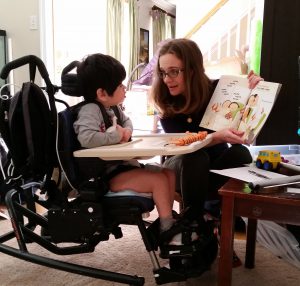 My new favorite book (and I’m pretty sure it is also Joey’s) is
My new favorite book (and I’m pretty sure it is also Joey’s) is 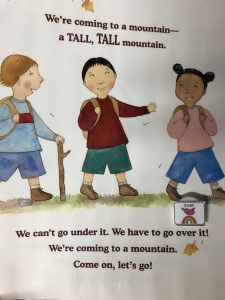 On Thursday, I handed Joey a few bright red maple leaves. He took one, held it up, looked at it, and then went to his eye gaze device. “Fire Engine” he said. “Fire engine.”
On Thursday, I handed Joey a few bright red maple leaves. He took one, held it up, looked at it, and then went to his eye gaze device. “Fire Engine” he said. “Fire engine.”
